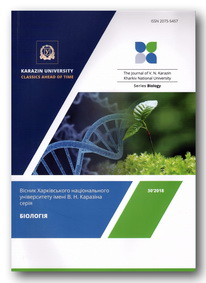Impact of amphiphilic compounds on post-hypertonic shock of human erythrocytes
Abstract
When the cryopreserved erythrocytes are thawed, with the ice melting the extracellular hypertonic medium changes to isotonic one, resulting in post-hypertonic cell lysis development. Under experimental conditions, the post-hypertonic shock of erythrocytes simulates the influence of cryodamage factors, acting at the erythrocyte thawing stage, as well as when the cells, cryopreserved under protection of penetrating cryoprotectant are transferred into bloodstream. Post-hypertonic shock of erythrocytes was carried out by transferring the cells from a hypertonic solution contained 1.65 mol/l NaCl (dehydration medium) into an isotonic one with 0.15 mol/l NaCl (rehydration medium) at 0ºС. The effect of specimens of various classes of amphiphilic compounds (anionic sodium decyl sulfate, non-ionic decyl-β,D-glucopyranoside, and cationic chlorpromazine) on the human erythrocyte sensitivity to post-hypertonic shock, was studied. Amphiphilic substances were supplemented into rehydration medium prior to cell introduction into it. It was shown that under post-hypertonic shock of erythrocytes, all the studied amphiphilic substances, when used in efficient concentrations, manifested a high anti-hemolytic activity (at the level of 70%). A comparative study of the efficiency of amphiphilic substances under post-hypertonic shock of erythrocytes showed differences in size of the plateau (the concentration range of amphiphilic compound, within the limits of which the minimum level of erythrocyte hemolysis was observed). Thus, it was found that for non-ionic decyl-β,D-glucopyranoside the plateau was 3 times more than for anionic sodium decyl sulfate and cationic chlorpromazine. The minimum efficient concentration for sodium decyl sulfate and the maximum one for decyl-β,D-glucopyranoside under post-hypertonic shock of erythrocytes were revealed. It is assumed that the revealed protective effect of amphiphilic compounds under post-hypertonic shock of erythrocytes is associated with their capability to integrate into membrane. This entails an increase in the surface area of the membrane and, therefore, the critical hemolytic volume of cell, which allows it to swell to a larger volume.
Downloads
References
Шпакова Н.М. Температурна та осмотична стійкість еритроцитів різних видів ссавців. Автореф. дис. … доктора биол. наук. – Харків, 2014. – 44с. /Shpakova N.M. Temperature and osmotic resistance of erythrocytes of different mammalian species. Abstract of Ph.D. thesis (Biology). – Kharkiv, 2014. – 44p./
Benga G. Comparative studies of water permeability of red blood cells from humans and over 30 animal species: an overview of 20 years of collaboration with Philip Kuchel // Eur. Biophys. J. – 2013. – Vol.42 (1). – P. 33–46.
Castro E., Taboada P., Barbosa S., Mosquera V. Size control of styrene oxide- ethylene oxide diblock copolymer aggregates with classical surfactants: DLS, TEM, and ITC study // Biomacromolecules. – 2005. – Vol.6. – P. 1438–1447.
Henkelman S., Lagerberg J.W., Graaff R. et al. The effects of cryopreservation on red blood cell rheologic properties // Transfusion. – 2010. – Vol.50 (11). – P. 2393–2401.
Iershov S.S., Pysarenko N.A., Orlova N.V., Shpakova N.M. Effect of cationic and anionic amphiphilic compounds on hypertonic cryohemolysis of mammalian red blood cells // Fiziolohichnyi zhurnal. – 2007. – Vol.53 (6). – P. 78–84.
Manaargadoo-Catin M., Ali-Cheri A., Pougnas J-L., Perrin C. Hemolysis by surfactant – a review // Advances in Colloid and Interface Science. – 2015. – Vol.228. – P. 1–16.
Mukhopadhyay R., Lim H.W.G., Wortis M. Echinocyte shapes: bending, stretching, and shear determine spicule shape and spacing // Biophys. J. – 2002. – Vol.82 (4). – P. 1756–1772.
Muldrew K. The salting-in hypothesis of post-hypertonic // Cryobiology. – 2008. – Vol.57 (3). – P. 251–256.
Piety N.Z., Reinhart W.H., Pourreau P.H. et al. Shape matters: the effect of red blood cell shape on perfusion of an artificial microvascular network // Transfusion. – 2016. – Vol.56 (4). – P. 844–851.
Sblano C., Micelli S., Notarachille G., Meleleo D. Effect of n-octyl-β-D-glucopyranoside on human and rat erythrocyte // The Open Biology Journal. – 2012. – Vol.5 (1). – P. 1–5.
Semionova E.A., Yershova N.A., Yershov S.S., Orlova N.V. Peculiarities of posthypertonic lysis in erythrocytes of several mammals // Probl. Cryobiol. Cryomed. – 2016a. – Vol.26 (1). – P. 73–83.
Semionova E.A., Iershova N.A., Orlova N.V., Shpakova N.M. Hypotonic lysis of mammalian erythrocytes in chlorpromazine presence // Eastern European Scientific Journal. – 2016b. – No. 2. – P. 7–17.
Semionova E.A., Chabanenko E.A., Orlova N.V. et al. About mechanism of antihemolitic action of chlorpromazine under posthypertonic stress in erythrocytes // Probl. Cryobiol. Cryomed. – 2017. – Vol.27 (3). – P. 219–229.
Tacheva B., Paarvanova B., Ivanov I.T. et al. Drug exchange between albumin nanoparticles and erythrocyte membranes // Nanomaterials (Basel). – 2019. – Vol.9 (1). – P. 47–61.
Zou L., Ding W., Sun S. et al. Fatigue damage to pig erythrocytes during repeated swelling and shrinkage // Cryobiology. – 2015. – Vol.71 (2). – P. 210–215.
Authors retain copyright of their work and grant the journal the right of its first publication under the terms of the Creative Commons Attribution License 4.0 International (CC BY 4.0), that allows others to share the work with an acknowledgement of the work's authorship.




